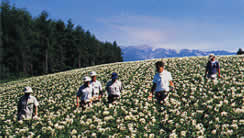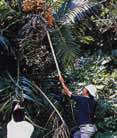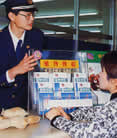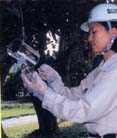 |
 |
 |
 |
 |
 |
 |
|
Field inspection of seed potatoes
|
|
 |
Domestic quarantine undertakes inspections on seed potato and major fruit nursery plants to certify freedom from the virus and other harmful diseases in order to provide healthy propagation materials to the farmers.
Harmful pests such as the sweet potato weevil and the giant African snail occur in the Southwestern Islands (Okinawa, Amami) and Ogasawara Islands but not in other regions of Japan. Movement of these pests and their host plants out of the habitat regions are legally prohibited.
Also, in case when a pest has invaded Japan and seriously endangers domestic agricultural production, the movement of host plants is restricted and the emergency control is initiated by the government.
|
|
 |
 |
|
Quarantine of domestic seedlings
|
 |
|
In order to secure healthy propagating materials for the farmers, plant quarantine officials inspect a certain designated plants during their growth. The seed potato is the only designated plant up to the present. Unless the seedlings have passed the inspection, their movement to the end-users is prohibited. In Hokkaido and ten other prefectures, seed potatoes are inspected for the freedom from nine kinds of pests including ring rot and virus diseases. Mother stocks of fruit nursery plants, from which scions are taken for propagation, are also subject to plant quarantine inspection for virus diseases. The plant items include citrus, apple, grape, pear, peach, cherry and plum.
|
 |
 |
|
Eradication programs on designated pests
|
 |
|
Against the pests which are specifically designated and regulated by domestic quarantine, prefectures undertake eradication programs with subsidies from the national government. The Plant Protection Station cooperates in the programs, monitors the result of the eradication control and gives the final decree on the success of the programs.
|
 |
 |
|
Monitoring survey for fruit fly eradication (Collection of fruits from wild host plants)
|
|
 |
The oriental fruit fly
The oriental fruit fly, which had inhabited the Southwestern Islands (Okinawa and Amami) and Ogasawara Is. was eradicated in 1986 with the total expenditure of 5 billion yen over 18 years.
|
The melon fly
The melon fly in the Southwestern Islands was exterminated in 1993 at the total cost of 20.4 billion yen over 22 years. Farmers in these regions now have a wider choice of tropical and subtropical crops to grow for the mainland market.
Thus, the success of the eradication campaigns has brought about a great positive impact upon the development of agricultural production in these regions.
At present, the eradication of the sweet potato weevil is underway in the Southwestern Islands.
|
|
|
|
|
 |
 |
|
Monitoring survey for newly invading pests
|
 |
 |
|
A check patrol for the movement of restricted plants
|
|
 |
 |
|
Monitoring survey for fruit flies
|
|
 |
It is vitally important to detect newly introduced pests in its early stage of outbreaks in order to take immediate control measures. In an attempt toward such purposes, the Plant Protection Station install lure-bait traps at major ports of entry and international post offices. In the inland areas, prefectural pest control centers also join in the monitoring survey programs for the newly introduced pests.
|
|
|
 |
 |
|
Emergency control
|
 |
|
To prevent the spread of harmful pests in Japan, the government undertakes emergency control. The Plant Protection Station joins in the operation and confirms the eradication for any further decisions to be taken on the program. The emergency control programs in the past are as follows.
|
 |
 |
| 1954-65 |
Potato tuber moth |
| 1965-69 |
Sweet potato weevil
(Eradicated in Kagoshima) |
| 1967-69 |
Citrus burrowing nematode
(Eradicated in Hachijo Is., Tokyo) |
| 1991-98 |
Sweet potato weevil
(Eradicated in Nishino-omote city (Tanegashima Is.), Kagoshima) |
| 1995 |
Sweet potato weevil
(Eradicated in Satsuma Peninsula, Kagoshima) |
| 1995-99 |
Bacterial shoot blight
(Eradicated in a part of Hokkaido) |
| 1996-98 |
Sweet potato weevil
(Eradicated in Muroto City, Kochi) |
| 1998-2000 |
Sweet potato weevil
(Eradicated in Yakushima, Kagoshima) |
| 1998-2004 |
West indian sweet potato weevil
(Eradicated in Yakushima, Kagoshima) |
| 2007- |
Citrus greening disease and Asian citrus psyllid
(Kikaijima Is., Kagoshima) |
|
|
 |